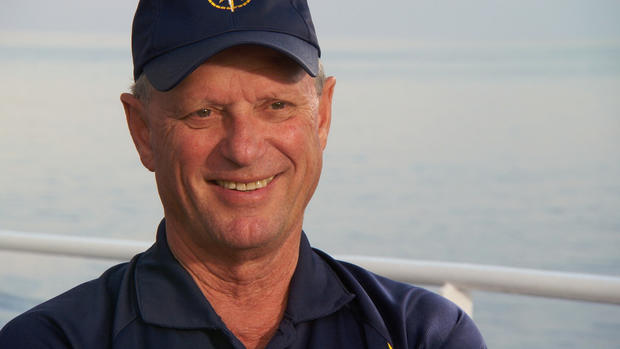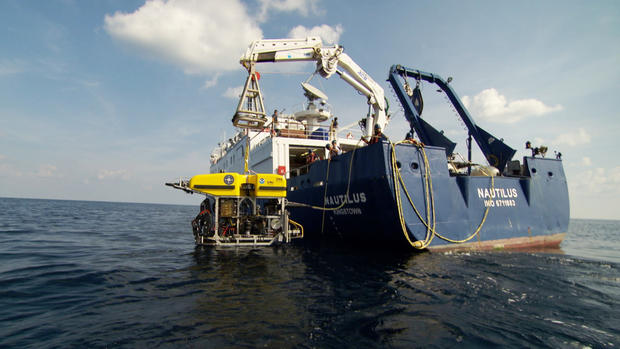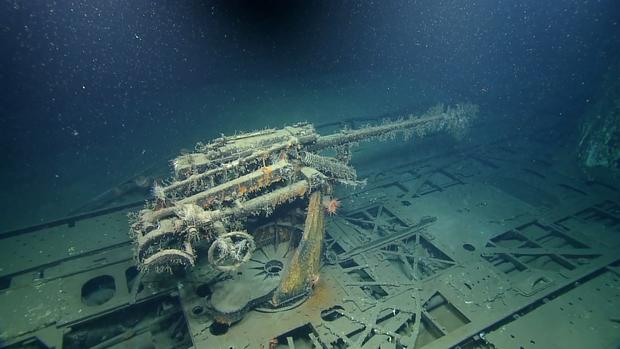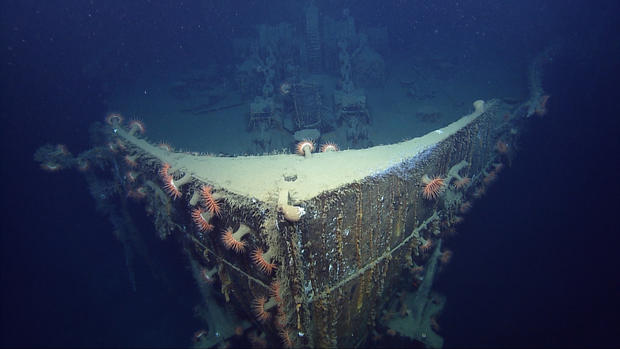The Unknown America
The following script is from "The Unknown America" which aired on May 10, 2015, and was rebroadcast on August 16, 2015. Lara Logan is the correspondent. Max McClellan, producer.
Robert Ballard has embarked on a new wave of American exploration, inspired by the epic journey of Lewis and Clark more than 200 years ago. This time, it's not over land, but in a part of the country that lies in the deep sea.
You may know Ballard as the man who found the Titanic. We first spent time with him a few years ago when he took us on a search for ancient shipwrecks in the Aegean Sea, but at the age of 73, he's changed course and come home. Why? Because the U.S. has jurisdiction over more ocean than any other country on Earth and beneath the waves lies trillions of dollars in untapped natural resources and, as we saw on our journey, a wealth of American history.
As we first reported in May, Robert Ballard calls it "the unknown America." We joined him about 100 miles off the coast of Mississippi in the Gulf of Mexico.
Robert Ballard: If you ask someone, "How much of the United States do you think lies beneath the sea?" They may say, "Five percent, or 10 percent." And when you tell them that half of their country lies beneath the sea and is unexplored, they don't believe you.
Lara Logan: Does it have a special meaning for you because it's home?
Robert Ballard: Yea, I'm 13th generation American. I love my country. And I served in the Army. I served in the Navy. I'm a boy scout, yeah.
Bob Ballard's "unknown America" stretches out to 200 nautical miles from all our coasts. This vast undersea area is called the U.S. Exclusive Economic Zone and the United States has sovereign rights over all the natural resources that lie there, like this methane gas Ballard filmed bubbling up from the seafloor off the coast of Louisiana.
The zone was established by President Ronald Reagan in 1983 and few realized that it more than doubled the area within America's boundaries.
Robert Ballard: Reagan may have signed a sheet of paper, but he did not follow it up with a modern-day version of a Lewis and Clark expedition to actually find out what we own.
Lara Logan: And, that's what you're doing?
Robert Ballard: That's what we're doing.
"Reagan may have signed a sheet of paper, but he did not follow it up with a modern-day version of a Lewis and Clark expedition to actually find out what we own."
With technology not fathomable during President Reagan's time, Ballard is exploring and mapping as much of these waters as he can aboard the Nautilus, this 200-foot state-of-the-art ship of exploration.
Robert Ballard: I mean, you can't manage something until you know what you've got. So, before you can exploit, you explore. And so that's what we are doing right now. We're trying to get a fundamental understanding of what we own.
[Ballard: We've got mapping cameras on there...]
His remotely operated vehicles can go down more than 13,000 feet. Hercules is armed with an array of cameras, Ballard's eyes under the sea. Argus hovers above, lighting up the depths with its powerful floodlights.
On our first day at sea, Ballard's team was on a mission for archaeologists with the U.S. government.
Robert Ballard: Oh, look at that.
Lara Logan: How far away are we now?
Robert Ballard: Meters. A hundred and some feet. And we're creeping up because we don't know what we're walking into. We're going down a dark alley.
He'd been given the coordinates for a mysterious object that had been picked up on sonar by Shell Oil and he was asked to find out what it was.
Lara Logan: What do you think it could be?
Robert Ballard: It's a ship.
Lara Logan: It is definitely?
Robert Ballard: Oh yea, look at that. It's a ship. It's just a question of whose ship and what ship and it's a big one. It's a big ship.
Lara Logan: There it is.
Robert Ballard: There we have it. We have visual.
Out of the darkness, nearly 8,000 feet below, a tangled web of cables and rope. It was an enormous ship, nearly two football fields in length.
Robert Ballard: Ohhh, it's in pretty good shape.
Lara Logan: I know, it's like it just landed there.
Ballard searched the ghostly site for clues.
Robert Ballard: There's an H-E - see that H-E?
Lara Logan: Yeah.
Robert Ballard: It's like battle ribbons or something.
Robert Ballard: I'm interested that all the windows are battened down -- see all those windows? They prepared it. You don't have time in a disaster to do that. Was this something sunk purposely? We're going to find out.
Lara Logan: It's fascinating to-- trying to unravel the mystery of it.
Robert Ballard: Yea, isn't it fun?
Lara Logan: Yea.
Bob Ballard has been unraveling deep-sea mysteries for 55 years -- and none better known than the Titanic, which he found in 1985 after others had tried and failed.
We asked him to show us around the Explorers Club in New York City, where he's honored as one of the greatest explorers of the past century, and he told us he's committed the rest of his life to searching America's seas.
Lara Logan: What is down there that you think you're going to find?
Robert Ballard: I've done close to 150 expeditions. And as I look back upon my history, the most important discoveries were the ones that I didn't know were there. I can only tell you that we've looked at so little there has to be huge new discoveries still waiting for us.
Part of what inspired his American exploration is what he calls the battlefields of the deep.
Lara Logan: But, right now we're in the Gulf of Mexico.
Robert Ballard: Yea.
Lara Logan: Beneath us is a World War II battlefield.
Robert Ballard: Yep. Most people don't realize that during World War II, German U-boats were right where we're sitting right now, sinking American ships. And lots of Americans were dying.
56 Allied ships were lost to the Nazis in the Gulf of Mexico -- part of a campaign Hitler called Operation Drumbeat. He celebrated Germany's U-boat victories in wartime propaganda films like this one.
Robert Ballard: OK, dead ahead. Get ready for a big baby.
One of those lost was an American passenger ship -- the Robert E Lee -- and, there she was, appearing slowly out of the gloom. This is what she used to look like, in one of the few surviving photographs taken just months before she was hit by a single torpedo in July 1942. She went down by the stern in about 10 minutes, taking 25 people with her, and came to rest nearly 5,000 feet below.
Robert Ballard: There you can see the decks and the passageways.
Lara Logan: Now, you can really see it.
72 years later, her windows were still intact, a bell still hanging in place, her gun still mounted to the stern.
Robert Ballard: This is an underwater national park. Just like a civil war battlefield. Just like going to Pearl Harbor. We're just a little deeper.
What's remarkable is that the Robert E Lee shares her watery grave with the U-boat that sank her -- the U-166 -- seen here during sea trials in this old German film. Now she lies under 5,000 feet of water. For decades no one knew these wrecks were just a few miles apart until BP and Shell Oil conducted a pipeline survey here in 2001.
Lara Logan: How many people died on here?
Robert Ballard: The whole crew.
Lara Logan: Their bodies are still inside?
Robert Ballard: They're still inside. That's a tomb.
[Ballard: Look at that, nicely done. Keep this up guys...]
Bob Ballard's mission was to try to film both wrecks in ways they hadn't been seen before.
Robert Ballard: So now you just go straight up and around like you're going to crawl up onto the deck. Look at that beautiful reveal. Oh I love that.
As luck would have it, the seas were calm and the images he captured are considered some of the clearest views of these sites. They're featured in a NOVA-National Geographic documentary.
Bob Ballard is not alone in his American adventure - his ship, the Nautilus, has joined forces with the Okeanos Explorer, operated by NOAA, the National Oceanic and Atmospheric Administration.
Robert Ballard: They're the only two official ships of exploration that the federal government has. I'd like to have 20, but I'll go for two. It's better than zero, which was just a few years ago.
Both the Nautilus and the Okeanos Explorer are mapping the seafloor using multi-beam sonar attached to their hulls -- a capability so powerful it used to be classified during the Cold War.
Lara Logan: How important is mapping to you in what the Nautilus is doing?
Robert Ballard: People think, "Well, the ocean's a big bathtub full of mud." Well, the largest mountain ranges on Earth are under the ocean. There are canyons down there that make the Grand Canyon look like a ditch. The biggest features on our planet are beneath the sea.
Ballard works closely with Larry Mayer, the Director of the Center for Coastal and Ocean Mapping at the University of New Hampshire -- a world leader in creating 3-D maps based on multi-beam data.
Larry Mayer: Our goal is to get the whole ocean mapped at this--
Lara Logan: To look like that.
Larry Mayer: Brilliant! We can do it. We've done it for the moon, we've done it for Mars. Let's do it for our own planet.
This is what the seafloor looks like with multi-beam data just 90 miles from New York City. You can see the Hudson Canyon, with walls 3,000 feet high. And here, you are looking at the New England seamounts far off the coast of Massachusetts, some rising 10,000 feet from the bottom of the ocean.
"Our goal is to get the whole ocean mapped....We can do it. We've done it for the moon, we've done it for Mars. Let's do it for our own planet."
Larry Mayer: Let's turn off the multi-beam data and just see what these mountains looked like without the multi-beam data.
Lara Logan: Look at that.
Larry Mayer: That's all you'd see. Yes, there was a bump and it would probably get close to getting the right height. But the difference is just something when we see what the multi-beam sonar adds.
Lara Logan: And, what do you gain from this knowledge?
Larry Mayer: It's giving us an insight. It's like lifting a veil. You know, all we've seen is the top of the water. Now we can see what's going on underneath.
Bob Ballard always travels with a team of scientists and on our trip they had come to take samples of the mussels living around this brine pool -- an underwater lake with its own shoreline. With no sunlight and almost no food at this depth, the mussels have learned to live off methane gas rising up from below.
Robert Ballard: And we want to understand how do they do that? Can we isolate them and use them? It's amazing what these organisms are processing and thriving in.
Lara Logan: So when you look at that, do you think about all the secrets that they're holding that we haven't unlocked yet?
Robert Ballard: Exactly. How do you do this and can we turn it to our advantage?
Ballard's team on the Nautilus explores for about six months a year, sailing with a crew of 50. And everything they do is shared in real time on the Internet, which is how this rare encounter with a sperm whale nearly 2,000 feet down in the Gulf of Mexico was seen around the world.
Scientists had been sampling seawater near the site of the BP Oil spill when this curious juvenile male circled Hercules for 15 minutes.
Robert Ballard: Scientists don't normally share their data right away. We share it the minute we collect it because we want everyone to help. We can't wait to turn the corner and go, what in the world is that. And then immediately, reach off the ship and call someone, wake 'em up. They're in bed and say, "Turn on your laptop!"
That's how Ballard's team identified that massive ship we saw earlier at the bottom of the Gulf.
[Ballard on phone: Yea, what the heck is it? It's a...It looks like a Naval vessel.]
Robert Ballard: You saw it work in a matter of minutes. We don't know what it is. And the archeologists and the maritime historian, they don't know what it is. And then people started coming in on the web and saying, you know, it's a Spruance-class destroyer.
It was an American warship, the USS Peterson.
One of the sailors who served on her gave us this footage of the night 14 Tomahawk missiles were launched from her deck into Baghdad in 1993 -- retaliation for an Iraqi plan to assassinate former President George H.W. Bush.
And just as Ballard suspected, the ship was sunk intentionally. We got this video from the U.S. Navy which shows them testing a new fire-fighting system aboard the Peterson 11 years ago. The Navy told us they sank her right afterwards, but they didn't share that information and those archeologists in the U.S. government who had turned to Bob Ballard had no idea the USS Peterson was down there.
Lara Logan: So that is one mystery solved?
Robert Ballard: Yep, chalk that one up. Next.
Lara Logan: And there'll be more.
Robert Ballard: There'll always be more. That's what's the fun of it. Can't wait for the next mystery.





